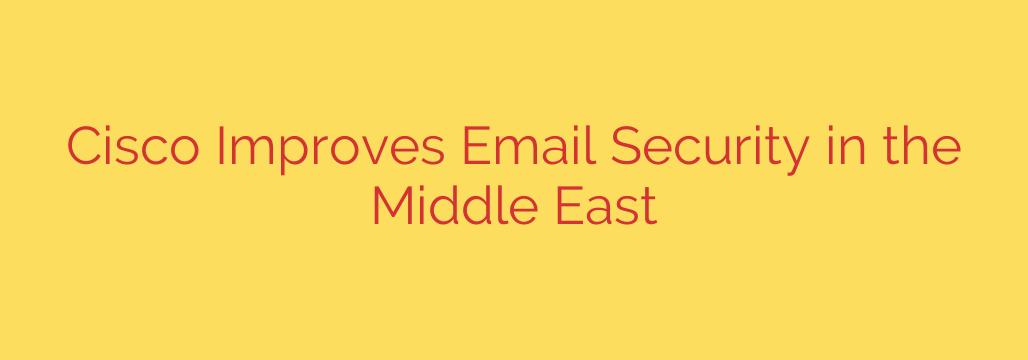
The New Frontier of Cyber Threats: Why Email Security in the Middle East is More Critical Than Ever
Email is the lifeblood of modern business—a vital tool for communication, collaboration, and commerce. But for every benefit it brings, it also carries a significant risk. Email remains the number one entry point for cyberattacks, and for businesses across the Middle East, this threat is escalating at an alarming rate.
As the region’s economies grow and digital transformation accelerates, they have become a prime target for sophisticated cybercriminals. Traditional email filters are no longer enough to stop today’s advanced attacks. Fortunately, a new generation of security solutions is rising to meet this challenge, offering robust protection tailored to the unique landscape of the Middle East.
The Evolving Threat Landscape: Beyond Simple Spam
Cybercriminals are moving past basic spam and viruses. Today’s threats are highly targeted, deceptive, and designed to bypass standard security measures. Organizations in the region must be prepared to defend against:
- Business Email Compromise (BEC): These are highly deceptive attacks where criminals impersonate executives or trusted vendors to trick employees into making unauthorized wire transfers or disclosing sensitive data. BEC attacks rely on social engineering, not malware, making them difficult for traditional systems to detect.
- Advanced Phishing and Credential Theft: Phishing emails are becoming increasingly realistic, perfectly mimicking legitimate brands and internal communications to steal login credentials for corporate networks and cloud services.
- Ransomware Delivery: Email is the most common delivery method for ransomware. A single click on a malicious link or attachment can encrypt an entire network, grinding business operations to a halt and demanding a hefty ransom.
- Data Exfiltration: Malicious insiders or compromised accounts can be used to leak sensitive corporate data, intellectual property, and customer information via email, leading to massive financial and reputational damage.
To combat these advanced threats, a new standard for email protection is essential. A significant development in this area is the establishment of new, in-region data centers dedicated to security processing. Hosting these services within the Middle East ensures lower latency for faster threat detection and helps organizations comply with local data sovereignty regulations.
Key Pillars of a Modern Email Security Strategy
An effective, modern email security platform moves beyond simple scanning and blocking. It provides a multi-layered defense designed to identify and neutralize the most sophisticated threats before they reach an employee’s inbox.
Here are the core features your organization should look for:
1. Advanced Phishing and Impersonation Detection
The best security platforms use machine learning and artificial intelligence to analyze communication patterns, sender reputations, and email content. This allows them to detect subtle signs of impersonation and BEC attacks that would otherwise go unnoticed. By understanding who you normally communicate with, the system can flag suspicious requests, even if they come from a seemingly legitimate email address.
2. Comprehensive Malware and Ransomware Defense
Stopping ransomware requires more than just checking for known virus signatures. Leading solutions use advanced sandboxing technology, where suspicious attachments and links are opened and analyzed in a safe, isolated environment. This allows the system to observe the file’s behavior and block any malicious actions before the threat can ever reach your network.
3. Integrated Data Loss Prevention (DLP)
Your email security shouldn’t just be about stopping threats from coming in; it must also prevent sensitive data from going out. Integrated DLP capabilities can identify and block emails containing confidential information like financial records, customer lists, or intellectual property from being sent outside the organization, whether accidentally or maliciously.
4. Seamless Integration with Cloud Email
Most businesses today rely on cloud-based email platforms. A modern security solution must integrate flawlessly with leading providers like Microsoft 365 and Google Workspace. This creates a powerful, layered defense that enhances the native security features of these platforms, closing critical gaps that cybercriminals actively exploit.
Actionable Steps to Fortify Your Defenses
Protecting your organization requires a proactive approach. Here are essential steps you can take today:
- Audit Your Current Defenses: Evaluate your existing email security. Is it capable of stopping BEC, ransomware, and advanced phishing? Don’t rely solely on the default security offered by your email provider.
- Prioritize Employee Training: Your employees are your human firewall. Conduct regular, ongoing security awareness training to teach them how to spot phishing emails, verify suspicious requests, and report potential threats.
- Implement Multi-Factor Authentication (MFA): Enforcing MFA across all accounts is one of the most effective ways to prevent a compromised password from leading to a full-blown breach.
- Develop an Incident Response Plan: Know exactly what to do when a security incident occurs. A clear plan ensures a swift and effective response, minimizing potential damage.
The digital landscape in the Middle East is filled with opportunity, but it also presents significant security challenges. As cyber threats grow in sophistication, your defenses must evolve as well. Investing in a robust, multi-layered email security strategy is no longer a choice—it’s an essential foundation for resilience, trust, and continued growth.
Source: https://feedpress.me/link/23532/17106330/cisco-delivers-enhanced-email-protection-to-the-middle-east








